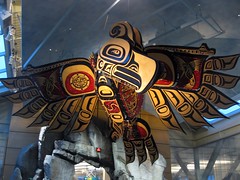Many First Nations sites were inhabited continually for centuries. The discarded shells and scraps of bone from their food formed enormous mounds called middens. Left over time, these unwanted dinner scraps can transform through a quiet process of preservationTime and pressure leach the calcium carbonate, CaCO3, from the surrounding marine shells and help “embalm” bone and antler artifacts that would otherwise decay. Calcium carbonate is a chemical compound that shares the typical properties of other carbonates.
CaCO3 is common in rocks and shells and is a useful antacid for those of you with touchy stomachs. In prepping fossil specimens embedded in limestone, it is useful to know that it reacts with stronger acids, releasing carbon dioxide: CaCO3(s) + 2HCl(aq) → CaCl2(aq) + CO2(g) + H2O(l)
For those of you wildly interested in the properties of CaCO3, may also find it interesting to note that calcium carbonate also releases carbon dioxide on when heated to greater than 840°C, to form calcium oxide or quicklime, reaction enthalpy 178 kJ / mole: CaCO3 → CaO + CO2. Calcium carbonate reacts with water saturated with carbon dioxide to form the soluble calcium bicarbonate. Bone already contains calcium carbonate, as well as calcium phosphate, Ca2, but it is also made of protein, cells and living tissue.
Decaying bone acts as a sort of natural sponge that wicks in the calcium carbonate displaced from the shells. As protein decays inside the bone, it is replaced by the incoming calcium carbonate, making the bone harder and thus more durable. The shells, beautiful in their own right, make the surrounding soil more alkaline, helping to preserve the bone and turning the dinner scraps into exquisite scientific specimens for future generations.



